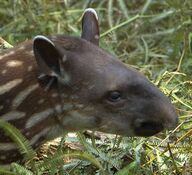
 Meet one of the Amazon's most recently discovered frog -- the tapir frog (photograph above by Germán Chávez)! So named for the shape of its snout, which is similar to the snout of a tapir (see inset photo left). The scientific names, Synapturanus danta, refers to how local people of the Putumayo river of Amazonian Peru call the Amazon tapir ("danta"). This new species of microhylid frogs live in the soils of stunted pole forests growing on peat, a type of ecosystem which is common in this region of northeastern Peruvian Amazonia. Synapturanus frogs are fossorial, and often overlooked during herpetological surveys and inventories, and thus their diversity is likely underestimated. Several putative new species have been suggested in different regions of the Amazon basin and the Guiana shield. It is likely that more species remain to be discovered, given the fossorial habits of these frogs reduce their detectability and their limited dispersal abilities may be associated with high endemism. Reference: Chávez, G., M.E. Thomson, D.A. Sánchez, J.C. Chávez-Arribasplata, A. Catenazzi. 2022. A needle in a haystack: Integrative taxonomy reveals the existence of a new small species of fossorial frog from Peru. Evolutionary Systematics 6: 9-20. https://doi.org/10.3897/evolsdoi.org/10.3897/evolsyst.6.80281
1 Comment
 We had the FIU Biosymposium last Saturday, 5 February at the beautiful FIU Biscayne Bay Campus. The FIU Biosymposium provides a chance for graduate students in the Department of Biological Sciences to present their work. Our lab was well represented, Anne gave a lightning talk titled The impact of carbon nanoparticles on the growth and development on tadpoles, and Rachel presented a poster titled Is chytrid avoidance an innate behavior in the strawberry poison frog?. Anne won first place in her category, congratulations Anne! |
Archives
June 2024
CATENAZZI LABNews from the lab Categories |


 RSS Feed
RSS Feed